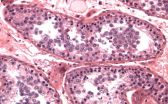(Press-News.org) GRAND RAPIDS, Mich., June 24, 2015 - Researchers at Spectrum Health Helen DeVos Children's Hospital have completed the first clinical trial of a new treatment for children suffering from neuroblastoma. In a clinical trial led by Giselle Sholler, MD, pediatric oncologist at Helen DeVos Children's Hospital and the Neuroblastoma and Medulloblastoma Translational Research Consortium (NMTRC), DFMO, an investigational agent, showed minimal side effects with long-term survival of three patients. This is the first clinical study of an oral dosing form of DFMO in any pediatric population.
"This DFMO trial is an important advancement in neuroblastoma research," explained Dr. Sholler. "We believe that by using DFMO to target an important cancer stem cell pathway to 'turn cells off,' we may prevent children from relapsing. Cancer cells have pathways that drive the cancer to grow and DFMO targets a specific pathway to turn these cells off."
Dr. Sholler recently published her laboratory studies describing how this drug works in neuroblastoma in preventing tumor formation in lab models and also published the full results of the phase one trial.
Will Lacey, a patient in the phase 1 clinical trial, was free from side effects and needed no additional treatment following the trial. This is a new way of life for a 10-year old whose neuroblastoma had kept him in and out of hospitals and on various treatments for most of his life.
Patrick Lacey, Will's father explained, "His quality-of-life has been amazing! He was never in the hospital and he was indistinguishable from his peers. Will has had an incredible two and a half years and has not required any further tumor directed therapy since."
Key findings of the trial include:
DFMO is well tolerated with minimal side effects in children with relapsed neuroblastoma
Children with specific genetic changes are predicted to have better response to DFMO
There were three patients enrolled in the trial who are now long-term survivors
Dr. Sholler's laboratory investigated the effectiveness of combining DFMO with the drug etoposide. She incorporated early work performed by Dr. Andre Bachmann, professor of pediatrics and human development at Michigan State University College of Human Medicine. Dr. Bachmann's work identified the relationship of this drug targeting the ODC gene in neuroblastoma. Dr. Sholler then designed and led a clinical trial to test the combination of drugs in children being treated for the disease at sites participating in the NMTRC. Dr. Sholler and NMTRC are now testing this concept in a Phase II clinical trial to prevent relapse.
"Since 2001, I have focused my research career on translating DFMO from bench to clinic, and a dream has come true," said Dr. Bachmann. "DFMO is now available to neuroblastoma patients thanks to Dr. Sholler and the wonderful NMTRC team."
Dr. Sholler received her M.D. from New York Medical College, in Valhalla, NY. She was a resident in pediatrics and, subsequently, a fellow in pediatric hematology/oncology at Brown University, before coming to international prominence for her work with relapsed neuroblastoma at the University of Vermont. She then transferred her clinical program to Helen DeVos Children's Hospital in Grand Rapids. She is now Haworth Endowed Director of the Innovative Therapeutics Clinic focused on early phase clinical trials for pediatric cancers and Department of Pediatrics. Here she sees patients as part of the NMTRC which she chairs. Dr. Sholler's lab research at Helen DeVos Children's Hospital where she runs the NMTRC Research Laboratory is focused on identifying new therapies for children with neuroblastoma.
INFORMATION:
About NMTRC
The Neuroblastoma and Medulloblastoma Translational Research Consortium (NMTRC) is a group of 24 universities and children's hospitals headquartered at the Helen DeVos Children's Hospital that offer a nationwide network of childhood cancer clinical trials. These trials are based on the research from a group of closely collaborating investigators who are linked with laboratory programs developing novel therapies for high-risk neuroblastoma and medulloblastoma.
About Spectrum Health
Spectrum Health is a not-for-profit health system, based in West Michigan, offering a full continuum of care through the Spectrum Health Hospital Group, which is comprised of 12 hospitals, including Helen DeVos Children's Hospital; 180 ambulatory and service sites; 1,300 physicians and advanced practice providers, which include 1,100 members of the Spectrum Health Medical Group; and Priority Health, a health plan with more than 648,000 members. Spectrum Health is West Michigan's largest employer, with 22,600 employees. The organization provided $294.6 million in community benefit during its 2014 fiscal year. Spectrum Health is the only health system in Michigan to be named one of the nation's 15 Top Health Systems® by Truven Health Analytics for 2015. This is the fourth time the organization has received this recognition.
spectrumhealth.org
Scientists have at their disposal a way to explore the possible prevention of genetic diseases before birth. But should they? Currently, the most promising path forward involves editing the genes of human embryos, a procedure rife with controversy. An article in Chemical & Engineering News (C&EN), the weekly newsmagazine of the American Chemical Society, parses the explosive issue.
Britt E. Erickson, a senior editor at C&EN, reports that at least one team of scientists has already published a study on altering disease-related genes of human embryos. The experiment was ...
In the most severe form of male infertility, men do not make any measurable levels of sperm. This condition, called azoospermia, affects approximately 1 percent of the male population and is responsible for about a sixth of cases of male infertility.
Oftentimes men with azoospermia don't know the underlying cause of their condition. But new research led by University of Pennsylvania scientists suggests that mutations in an X chromosome gene called TEX11 are responsible for a significant number of cases of infertility -- an estimated 1 percent of cases of non-obstructive ...
Complex magnetic structures are at the heart of promising new materials for devices in "spintronics", a field of research aiming at more energy efficient data storage and processing. A prominent example is the so-called spin valve, where the magnitude of the electrical current passing through a device is very sensitively dependent on its magnetic configuration. These configurations can be readily controlled by a magnetic field in artificial layer systems, resulting in the giant magnetoresistance effect (GMR), a discovery rewarded with the 2007 Noble price in physics to ...
College Park, Md. -- Extreme heat and precipitation events, which are expected to increase in frequency and intensity due to climate change, are associated with increased risk of Salmonella infections, according to a study led by researchers from the University of Maryland School of Public Health. The study is the first to provide empirical evidence that Salmonella infections related to extreme weather events are disproportionately impacting those living in the coastal areas of Maryland.
"We found that extremely hot days and periods of extreme rainfall are contributing ...
When ecologists gather in Baltimore, Md., this August for the 100th Annual Meeting of the Ecological Society of America, special attention will fall on the local Chesapeake Bay watershed, with field trips and research presentations exploring its rich wildlife and social history. At symposia, poster exhibits, and site visits, ecologists will have opportunities to discuss the latest research and experiences working with stakeholders in the region to improve the health of the nation's largest estuary.
Chesapeake Bay bears a heavy pollution burden from the growing metropolitan ...
PHILADELPHIA - Despite findings of previous studies and published guidelines, nearly two-thirds of patients with T4a larynx ("voice box") cancer are not receiving a total laryngectomy (surgical removal of the larynx), the recommended form of treatment, and as a result, have significantly worse survival rates versus those treated with a total laryngectomy, a new study published in the International Journal of Radiation Oncology, Biology and Physics by experts at Penn Medicine found. Patients who underwent a laryngectomy, on average, lived nearly two years longer than those ...
From today (1 July 2015) The BMJ requires sharing of individual patient data for all clinical trials.
This means that trials will be considered for publication only if the authors agree to make the relevant anonymised patient level data available on reasonable request.
The BMJ is the first general medical journal to require data sharing for all trials, extending its initial policy on sharing data for trials of drugs or devices, which took effect in January 2013, says Elizabeth Loder, The BMJ's acting head of research.
In an editorial to mark the launch of the new ...
The stress hormone cortisol strengthens memories of scary experiences. However, it is effective not only while the memory is being formed for the first time, but also later when people look back at an experience while the memory reconsolidates. This has been published by cognition psychologists from the Ruhr-Universität Bochum in the journal "Neuropsychopharmacology". They suggest that the results might explain the persistence of strong emotional memories occurring in anxiety and Post-Traumatic Stress Disorder (PTSD).
Memories of emotional experiences usually fade ...
Thin fibers play a tremendous role in many areas of our daily life, from the use of glass fibers in ultra-fast data transmission to textile fibers in our clothing. In order to enable special properties of these fibers, they are often coated with a thin liquid layer that is supposed to be stable and homogeneous. However, for the production of drinkable water, the exact opposite features are desired: there, one aims at harvesting water, which is transported along the fiber as a liquid film or as liquid droplets, from fog. Now, scientists have been able to reveal, by means ...
This news release is available in German. Observing time at the European Southern Observatory (ESO) on Paranal Mountain is a very precious commodity - and yet the Very Large Telescope (VLT) in Chile spent an entire night with a high-resolution infrared camera pointed at a single object in the night sky. The data collected by the Naco optics instrument enabled an international team headed by ETH Zurich's Sascha Quanz to confirm its earlier hypothesis: that a young gas planet - presumed not unlike Jupiter in our own solar system - is orbiting the star designated HD 100546.
At ...

